Chris Hedges: ‘Dying for an iPhone’
The suffering of the working class, within and outside the United States, is ignored by our corporatized media, and yet, it is one of the most important human rights issues of our era.
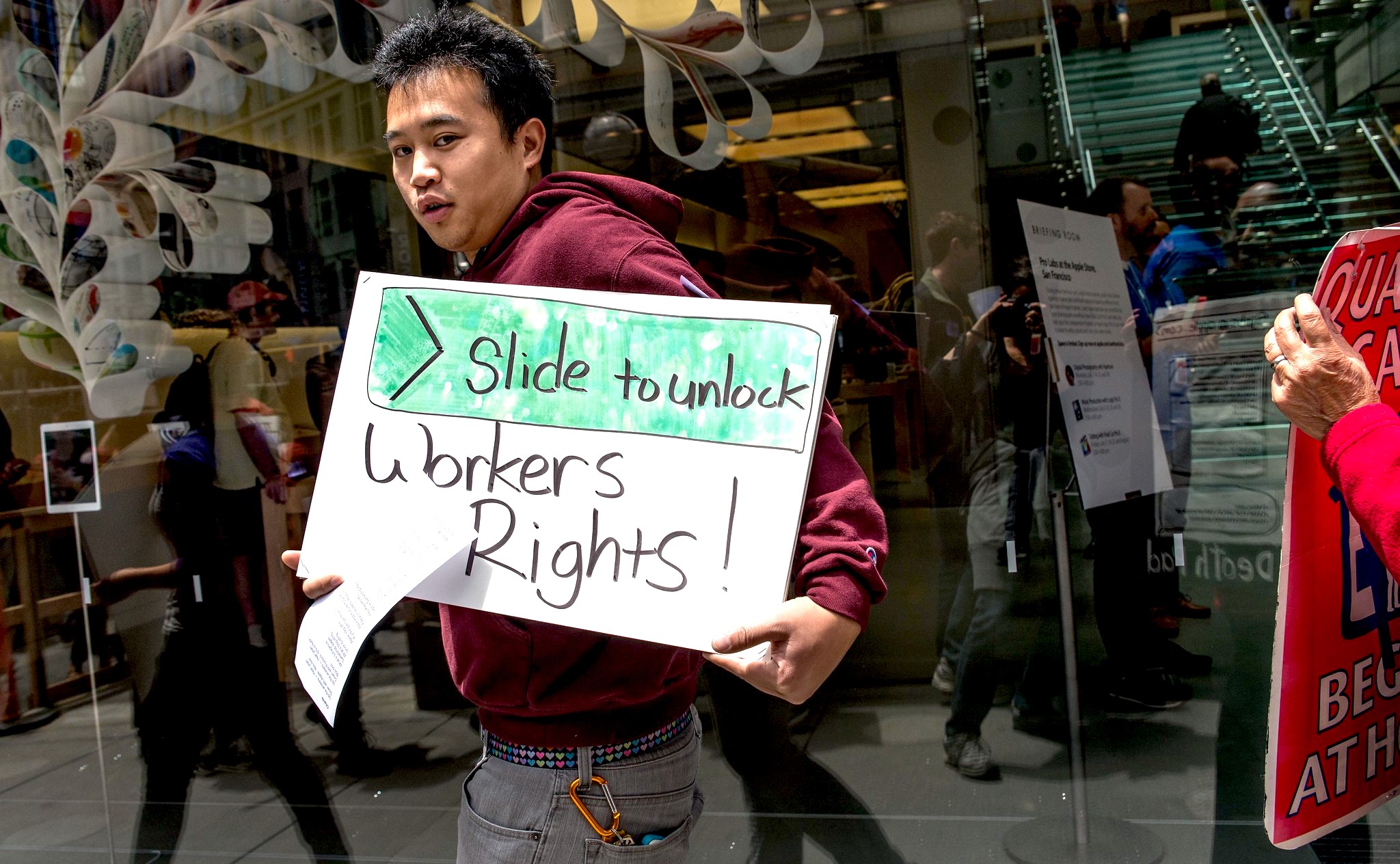
Apple protest, San Francisco, July 2014. (Annette Bernhardt, Flickr, CC BY-SA 2.0)
 Global capitalists have turned back the clock to the early days of the Industrial Revolution. The working class is increasingly bereft of rights, blocked from forming unions, paid starvation wages, subject to wage theft, under constant surveillance, fired for minor infractions, exposed to dangerous carcinogens, forced to work overtime, given punishing quotas and abandoned when they are sick and old. Workers have become, here and abroad, disposable cogs to corporate oligarchs, who wallow in obscene personal wealth that dwarfs the worst excesses of the Robber Barons.
Global capitalists have turned back the clock to the early days of the Industrial Revolution. The working class is increasingly bereft of rights, blocked from forming unions, paid starvation wages, subject to wage theft, under constant surveillance, fired for minor infractions, exposed to dangerous carcinogens, forced to work overtime, given punishing quotas and abandoned when they are sick and old. Workers have become, here and abroad, disposable cogs to corporate oligarchs, who wallow in obscene personal wealth that dwarfs the worst excesses of the Robber Barons.
In fashionable liberal circles there are, as Noam Chomsky notes, worthy and unworthy victims. Nancy Pelosi has called on global leaders not to attend the Winter Olympics, scheduled to be held in Beijing in February, because of what she called a “genocide” being carried out by the Chinese government against the Uyghur minority.
New York Times columnist Nick Kristof in a column rattled off a list of human rights violations overseen by China’s leader Xi Jinping, writing “[Xi] eviscerates Hong Kong freedoms, jails lawyers and journalists, seizes Canadian hostages, threatens Taiwan and, most horrifying, presides over crimes against humanity in the far western region of Xinjiang that is home to several Muslim minorities.”
Not a word about the millions of workers in China who are treated little better than serfs. They live separated from their families, including their children, and housed in overcrowded company dormitories, which sees rent deducted from their paychecks, next to factories that have round-the-clock production, often making products for U.S. corporations. Workers are abused, underpaid and sickened from exposure to chemicals and toxins such as aluminum dust.
 The suffering of the working class, within and outside the United States, is as ignored by our corporatized media as the suffering of the Palestinians. And yet, I would argue, it is one of the most important human rights issues of our era, since once workers are empowered, they can fend off other human rights violations.
The suffering of the working class, within and outside the United States, is as ignored by our corporatized media as the suffering of the Palestinians. And yet, I would argue, it is one of the most important human rights issues of our era, since once workers are empowered, they can fend off other human rights violations.
Unless workers can organize, here and in countries such as China, and achieve basic rights and living wages, it will cement into place a global serfdom that will leave workers trapped in the appalling conditions described by Friedrich Engels in his 1845 book “The Conditions of the Working Class in England” or Émile Zola‘s 1885 masterpiece “Germinal.”
As long as China can pay slave wages it will be impossible to raise wages anywhere else. Any trade agreement has to include the right of workers to organize, otherwise all the promises by Joe Biden to rebuild the American middle class is a lie.
Between 2001-2011, 2.7 million jobs were lost to China with 2.1 million in manufacturing. None are coming back if workers in China and other countries that allow corporations to exploit labor and skirt basic environmental and labor regulations are locked in corporate servitude. And while we can chastise China for its labor policies, the United States has crushed its own union movement, allowed its corporations to move manufacturing overseas to profit from the Chinese manufacturing models, suppressed wages, passed anti-labor right-to-work laws, and demolished regulations that once protected workers.
The war on workers is not a Chinese phenomenon. It is a global one. And U.S. corporations are complicit. Apple has 46 percent of its suppliers in China. Walmart has 80 percent of its suppliers in China. Amazon has 63 percent of its suppliers in China.
The largest U.S. corporations are full partners in the exploitation of Chinese labor, and the abandonment and impoverishment of the American working class. U.S. corporations and Chinese manufacturers kept millions of Chinese workers crammed into factories at the height of a global pandemic. Their health was of no concern. Apple’s profits more than doubled to $23.6 billion in the most recent quarter. Its revenues rose by 54 percent to $89.6 billion, which meant Apple sold more than $1 billion on average each day. Until these corporations are held accountable, which the Biden administration will not do, nothing will change for workers here or in China. Economic justice is global or it does not exist.
Workers in Chinese industrial centers — self-contained company cities with up to a half million people — drive the huge profits of two of the world’s most powerful companies, Foxconn, the world’s largest provider of electronics manufacturing services, and Apple, with $ 2 trillion dollars in market value. Foxconn’s largest customer is Apple, but it also produces products for Alphabet (formerly Google), Amazon, which owns more than 400 private-label brands, BlackBerry, Cisco, Dell, Fujitsu, GE, HP, IBM, Intel, LG, Microsoft, Nintendo, Panasonic, Philips, Samsung, Sony, and Toshiba, as well as leading Chinese firms including Lenovo, Huawei, ZTE, and Xiaomi. Foxconn assembles iPhones, iPads, iPods, Macs, TVs, Xboxes, PlayStations, Wii U’s, Kindles, printers, as well as numerous digital devices.
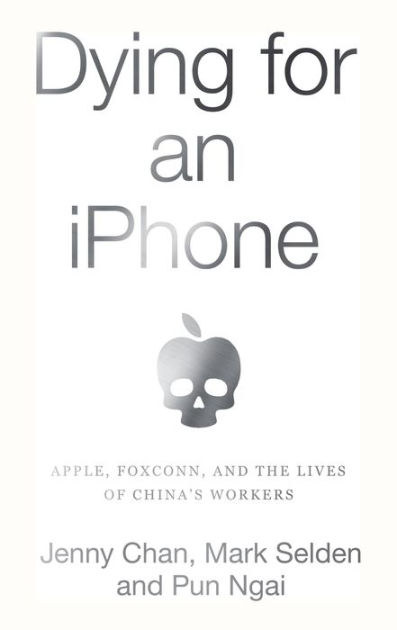 Jenny Chan, Mark Selden and Pun Ngai spent a decade conducting undercover research at Foxconn’s major manufacturing sites in the Chinese cities of Shenzhen, Shanghai, Kunshan, Hangzhou, Nanjing, Tianjin, Langfang, Taiyuan and Wuhan for their book Dying for an iPhone: Apple, Foxconn, and The Lives of China’s Workers.
Jenny Chan, Mark Selden and Pun Ngai spent a decade conducting undercover research at Foxconn’s major manufacturing sites in the Chinese cities of Shenzhen, Shanghai, Kunshan, Hangzhou, Nanjing, Tianjin, Langfang, Taiyuan and Wuhan for their book Dying for an iPhone: Apple, Foxconn, and The Lives of China’s Workers.
What they describe is an Orwellian dystopia, one where global corporations have perfected the techniques for a disempowered work force. These vast worker cities are little more than labor penal colonies. Yes, it is possible to leave, but to incur the ire of the bosses, especially by speaking out or attempting to organize, is to be blacklisted for life throughout China’s archipelago of industrial centers and cast to the margins of society or often prison.
Workers live under constant surveillance. They are policed by company security units. They sleep in segregated male and female dormitories with eight or more people to a room. The multi-story dormitories have bars on the windows and nets below, put up to halt the spate of worker suicides that afflicted these factory cities a few years ago.
“The workplace and living space are compressed to facilitate high-speed, round-the-clock production,” the authors write. “The dormitory warehouses a massive migrant labor force without the care and love of family. Whether single or married, the worker is assigned a bunk space for one person. The ‘private space’ consists simply of one’s own bed behind a self-made curtain with little common living space.”
Workers, who earn about $2 an hour and an average of $390 a month, are paid in wage debit cards, an updated version of company scrip. The bank card allows a worker to deposit, withdraw, and transfer money from 24-hour ATM machines that are accessible at Foxconn facilities.
Managers, foremen, and line leaders prohibit conversation on the assembly floor that operates on a 24-hour cycle of 10- or 12-hour shifts. Workers are reprimanded if they work “too slowly” on the line. They are punished for turning out defective products. Workers are often forced to remain behind after a shift if a worker committed an infraction. The worker who violated the rules is required to stand before his or her co-workers and read a statement of self-criticism. Any worker issued a “D” grade in their review for “unsatisfactory performance” is fired. The workers receive one day off every second week, or two rest days a month. They can be summarily shifted between the night and day shifts.
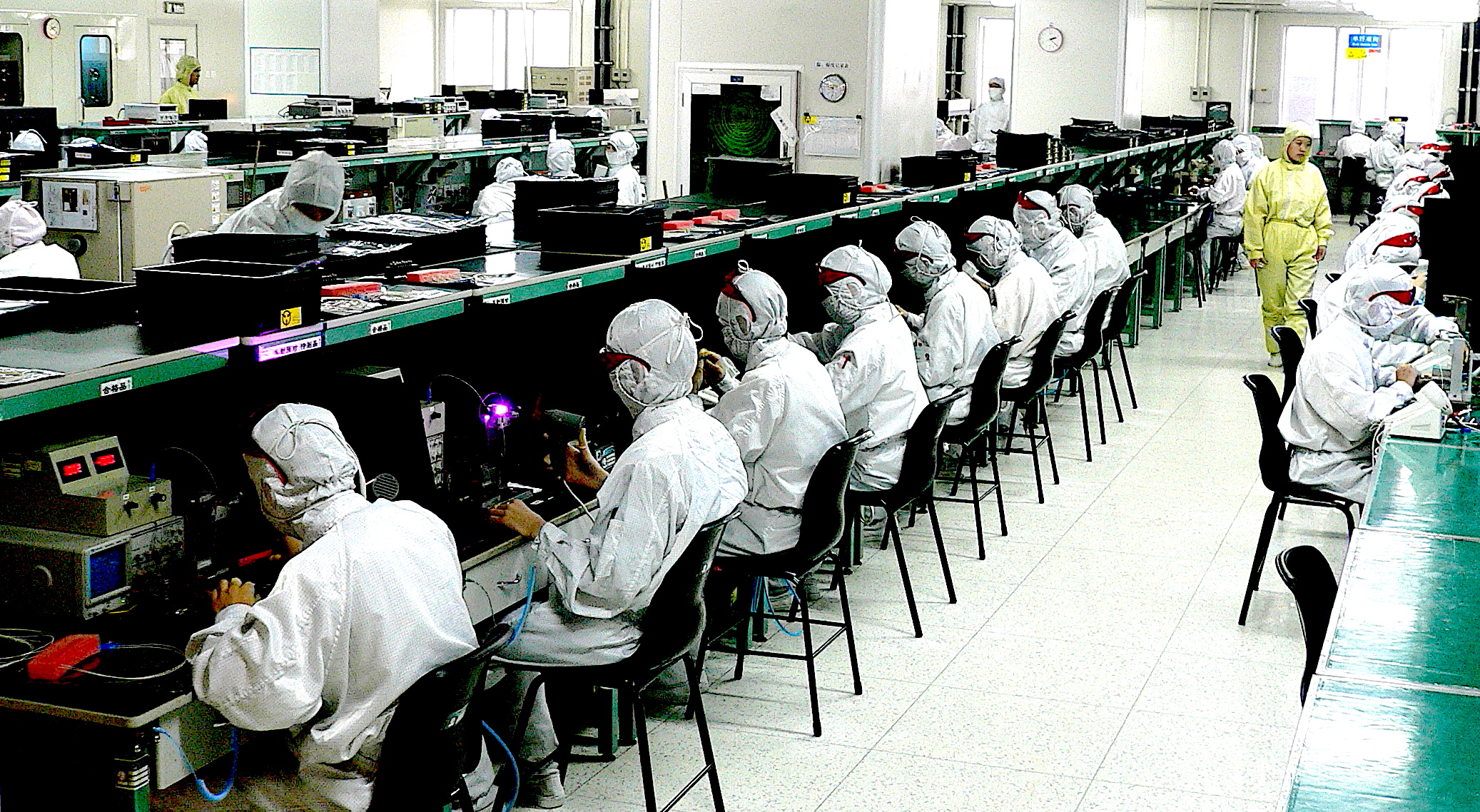
Production floor in Foxconn factory at Shenzhen, China, 2005. (Steve Jurvetson, CC BY 2.0, Wikimedia Commons)
The authors describe the daily routine of a worker entering a Foxconn factory at 7 a.m. with hundreds of thousands of other Foxconn employees. Each person, prohibited from entering the factory complex with electronic devices, is checked by facial recognition systems to confirm his or her identity.
“The human flow continues for more than an hour. Night-shift workers cross the footbridge and pour into the shopping malls and street markets that have sprung up around the factory. Day-shift workers cross the same footbridge, in the opposite direction, heading to work. From the moment they enter the factory gate, workers are monitored by a security system more intrusive than any that we found in the neighboring smaller electronics-processing factories. ‘Foxconn has its own security force, just as a country has an army,’ a stern faced, broad-shouldered security officer stated as a matter of fact. Workers pass through successive electronic gates and Special Security Zones before arriving at their workshops to start work.”
Once inside, the authors write, workers endure a familiar ritual:
“As workers prepare to begin a shift, managers call out: ‘How are you?’ Workers must respond by shouting in unison, ‘Good! Very good! Very, very good!’ This drill is said to foster disciplined workers. A laser-soldering worker reported, ‘Before shift-time, a whistle sounds three times. At the first whistle we must rise and put our stools in order. At the second whistle we prepare to work and put on special gloves or equipment. At the third whistle we sit and work. ‘No talking, no laughing, no eating, no sleeping’ during work hours is the number one factory rule. Any behavior that violates discipline is penalized. ‘Going to the toilet for more than ten minutes incurs an oral warning, and chatting during work time incurs a written warning,’ a line leader explained.
The work is exhausting, stressful and repetitive. An iPhone has more than one hundred parts. “Every worker,” the authors write, “specializes in one task and performs repetitive motions at high speed, hourly, daily, ten hours or more on many working days, for months on end.”
A woman interviewed in the book described her life on the assembly line:
“I am a cog in the visual inspection workstation, which is part of the static electricity assembly line. As the adjacent soldering oven delivers smartphone motherboards, both my hands extend to take the motherboard, then my head starts shifting from left to right, my eyes move from the left side of the motherboard to the right side, then stare from the top to the bottom, without interruption, and when something is off, I call out, and another human part similar to myself will run over, ask about the cause of the error, and fix it. I repeat the same task thousands of times a day. My brain rusts.”
The work can also be hazardous. The polishing machine emits aluminum dust as it grinds the casings. This dust gets into the eyes and causes irritation and tiny tears. Workers suffer from respiratory problems, sore throats and chronic coughs. “Microscopic aluminum dust coats workers’ faces and clothes,” the authors write. “A worker described the situation this way: ‘I’m breathing aluminum dust at Foxconn like a vacuum cleaner. With the workshop windows tightly shut, workers felt that they were suffocating.’”
The aluminum dust can also cause fires, such as one on May 20, 2011, when an accumulation of aluminum dust in the air duct on the third floor at Foxconn Chengdu Building A5 was ignited by a spark from an electric switch. Four workers died. Dozens were injured. It was not the only explosion, which Foxconn managed to largely hide by imposing a near total media blackout. “Seven months after the Foxconn tragedy, on December 17, 2011, combustible aluminum dust fueled another blast, this time at iPhone maker Pegatron in Shanghai, injuring sixty-one workers. In the blast, young men and women suffered severe burns and shattered bones, leaving many permanently disabled,” the authors write.
Workers are required to clean one thousand iPhone touchscreens per shift. They were cleaned for years with the chemical n-hexane, which evaporates faster than industrial alcohol. Prolonged exposure to n-hexane damages peripheral nerves, leading to painful muscle cramps, headaches, uncontrollable shaking, blurred vision and difficulties walking. It should only be applied in well ventilated areas by workers wearing respirators. Thousands of Foxconn workers applied n-hexane in sealed rooms without ventilators and were sickened, finally leading to its ban.
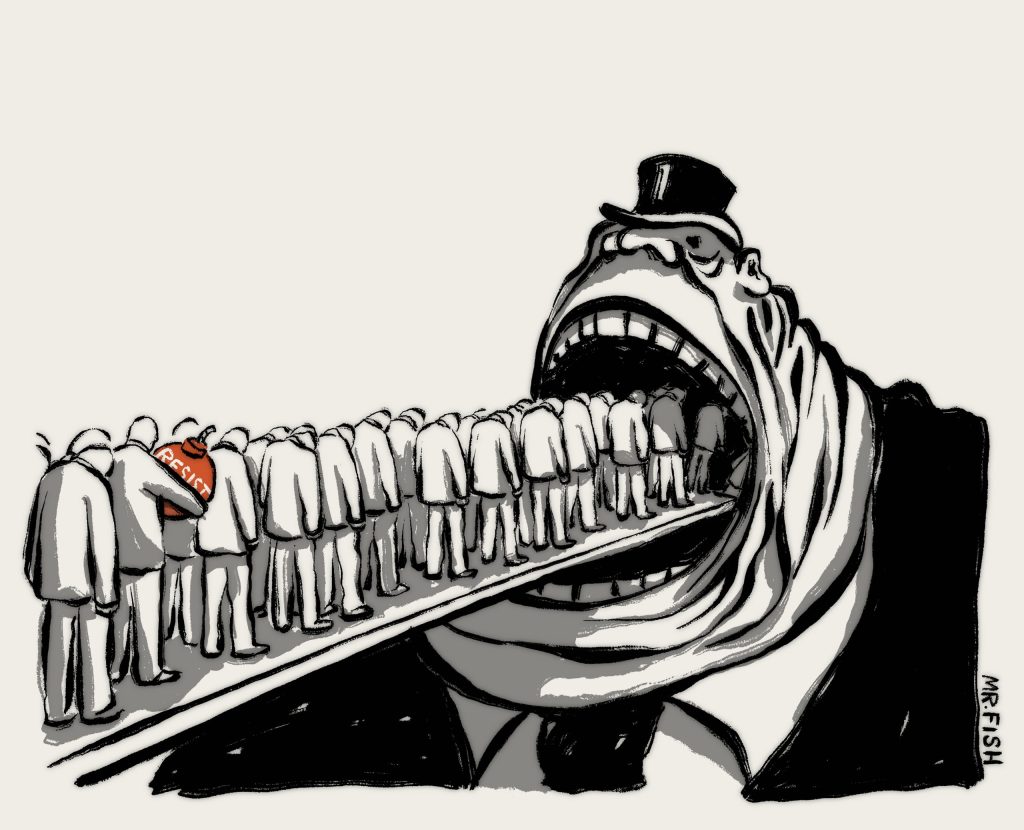
“Resist.” (Illustration by Mr. Fish)
These vast industrial complexes also discharge huge amounts of heavy metals and wastewater into the rivers and ground water. Rivers near plants run black with sewage and are filled with plastic waste. Workers complain that the drinking water is discolored and smells.
The United States cast its workers aside in the 1990s with de-industrialization. China did the same by dismantling socialism in favor of state-controlled capitalism. State and collective sector jobs in China fell from 76 percent in 1995 to 27 percent in 2005. Tens of millions of laid off workers were left to compete for jobs run by corporations such as Foxconn. But even these jobs are now under threat, partly from automation, with workers on assembly lines replaced by robotic automatons that can spray, weld, press, polish, do quality testing and assemble printed circuit boards. Foxconn has installed over 40,000 industrial robots in its factories, along with hundreds of thousands of other automated machines.

Apple protest, San Francisco, July 2014. (Annette Bernhardt, Flickr, CC BY-SA 2.0)
But over the past decade, the authors note, “the major changes inside Foxconn were not the replacement of workers with robots but the replacement of full-time employees with growing numbers of student interns and contingent subcontracted laborers.”
These workers, part of the gig economy familiar in the United States, have even less job stability and security than full time employees. As many as 150,000 high-school age vocational students are employed in Foxconn plants. They are paid the minimum wage, but are not entitled to the 400-yuan-per-month skills subsidy, even if they pass the probationary period. Foxconn is also not required to enroll them in social security.
Those who lead these corporate behemoths often replicate the behavior of despots, not only exerting total control over every aspect of their workers lives but dispensing folksy wisdom to the masses. They are often treated by a fawning media as gurus, asked to opine–as Bill Gates, Warren Buffet, Elon Musk and Jeff Bezos do–on a range of social, economic, political and cultural issues. Their immense fortunes confer to them in our Mammon-worshipping society a sage-like status.
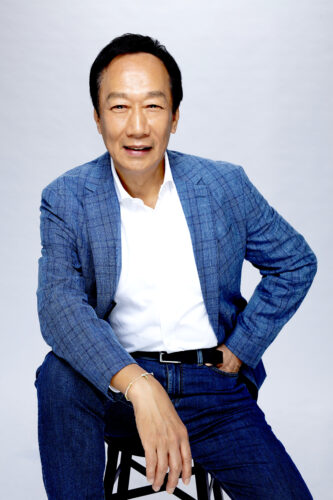
Terry Gou in 2019. (CC BY-SA 4.0, Wikimedia Commons)
Terry Gou, the founder and CEO of Foxconn, has published a list of slogans and aphorisms that adorn the walls of his factories, along with his portraits. Workers are required to write out passages from “Gou’s Quotations.” While Mao Zedong called for class struggle and rebellion, Gou calls for conformity and blind obedience. “Growth thy name is suffering,” reads one of his quotes. The Wall Street Journal reporter Jason Dean, in a 2007 interview with Gou, characterized Gao as a “warlord,” and noted that “he wears a beaded bracelet he got from a temple dedicated to Genghis Khan, the thirteenth-century Mongolian conqueror whom he calls a personal hero.”
“A harsh environment is a good thing,” one of Gou’s quotes reads. “Achieve goals or the sun will no longer rise. Value efficiency every minute, every second. Execution is the integration of speed, accuracy, and precision.”
His more than one million employees, as is true at Amazon and other large corporations, are subjected to mandatory company meetings where they are taught to obey company rules, pay fealty to the interests of the corporation and, as the authors note, strive for “the individualistic model of success.” Those who heed the rules, workers are told, are rewarded. Those who do not, are punished or banished.
Workers in these global sweatshops are organizing underground and protesting. There were 8,700 incidents of labor unrest in China in 1993, the first year for which official data is available, which rose to 32,000 in 1999, the authors write. “The number ‘continued to increase at more than 20 percent a year’ between 2000 and 2003. In 2005, the official record noted 87,000 cases, rising to 127,000 in 2008 during the world recession–the last time the Chinese Ministry of Public Security released figures.”
In Hubei’s East Lake High-Tech Development Zone, the authors note, known as Optics Valley, on Jan. 3, 2012, 150 Foxconn workers threatened to jump from the roof of the factory and commit mass suicide if the managers refused to address their demands, which included protests over forced transfers to other factories’ cities and a wage dispute.
Strikes, protests and work stoppages that take place now are state secrets, but the past statistics seem to indicate that they are growing. Strikes are usually swiftly and brutally broken by company security and police, with strike leaders being fired and often imprisoned.
We will not save ourselves through the perverted individualism, sold to us by our corporate masters and a compliant mass media, which encourages our advancement at the expense of others. We will save ourselves by working in solidarity with workers inside and outside the United States. This collective power is our only hope. Amazon workers from the Hulu Garment factory in Phnom Penh, Cambodia, and Global Garments factory in Chittagong, Bangladesh, recently led a global day of action to make Amazon pay all its workers, no matter where they live, fair wages. This has to be our model. Otherwise, workers in one country will be pitted against workers in another country. Karl Marx and Friedrich Engels got it right. Workers of the world unite. You have nothing to lose but your chains.
Chris Hedges is a Pulitzer Prize–winning journalist who was a foreign correspondent for 15 years for The New York Times, where he served as the Middle East bureau chief and Balkan bureau chief for the paper. He previously worked overseas for The Dallas Morning News, The Christian Science Monitor and NPR. He is the host of the Emmy Award-nominated RT America show “On Contact.”



Geen opmerkingen:
Een reactie posten